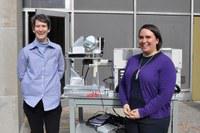Since ACE launched into the stratosphere on board a small Canadian satellite known as SCISAT a decade ago it has provided a steady stream of data that have played a huge role in understanding the depletion and recovery of the ozone layer.
“We’re thrilled to share the great success of SCISAT and remember that day when the satellite took its first measurements and reported back,” said U of T physicist Kaley Walker , deputy mission scientist of ACE. “This has been a great experiment to work on for U of T.”
SCISAT’s 650-kilometre-high orbit takes it over the polar regions of the Earth, as well as tropical and mid-latitude locations. It measures more than 30 different chemicals – more than any other satellite – that influence the distribution of stratospheric ozone, particularly in the Arctic.
ACE data have also validated environmental policy aimed at protecting the ozone layer. The Montreal Protocol, signed by United Nations leaders in 1987, prohibits the production and consumption of chlorofluorocarbons (CFCs), requires that refrigerants and fire extinguishers be recycled properly and bans the release of ozone-depleting refrigerants when servicing air conditioners or refrigeration equipment.
ACE data show that, since the ban, the concentrations of these ozone-depleting substances in the atmosphere are decreasing.
The two instruments aboard SCISAT – the Fourier Transform Spectrometer (FTS) and the Measurements of Aerosol Extinction in the Stratosphere and Troposhere Retrieved by Occultation (MAESTRO) – have doubles that stay on Earth. Each spring, the ground-based instruments travel to Eureka, Nunavut to verify the data produced by the satellite.
SCISAT has also been able to collect data on other environmental dangers, including pollution from wildfires and forest fires and volcanoes.
“The ACE mission is still going strong,” said Walker. “We look forward to what else we can observe with it as our mission continues.”
Author: Jessica Lewis
Source: http://news.utoronto.ca/climate-tracking-experiment-celebrates-10-years

